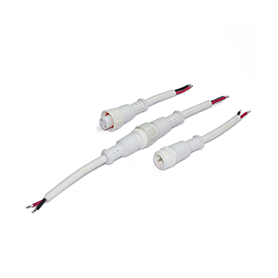News


News

Key Considerations When Using Waterproof Power Connectors
Release time:2025-03-20
viewed:320
Waterproof power connectors play a vital role in electrical systems, especially in harsh environments such as outdoor, industrial, automotive, and marine applications. They effectively prevent water, dust, and other contaminants from entering connection points, ensuring the reliability and safety of electrical systems. However, to maximize their performance and extend their lifespan, there are several key considerations to keep in mind when using waterproof power connectors.

The IP (Ingress Protection) rating of a waterproof power connector determines its ability to resist water and dust ingress. Selecting the appropriate IP rating for your application is crucial:
IP67: Suitable for temporary immersion (up to 1 meter for 30 minutes), such as outdoor lighting or automotive exterior connections.
IP68: Suitable for prolonged immersion (beyond 1 meter), such as underwater equipment or marine electrical systems.
IP69K: Suitable for high-pressure, high-temperature water jets, such as industrial cleaning equipment.
Important Notes:
Ensure the selected connector's IP rating meets the requirements of your specific environment.
IP ratings are based on laboratory conditions; actual performance depends on sealing materials and structural design.
Improper installation is a leading cause of waterproof connector failure. Here are some installation tips:
Before installation, ensure the connector and cable surfaces are clean, free of oil, dust, or other contaminants.
Use a clean cloth or alcohol to wipe the connection area.
Check the sealing ring (O-ring or silicone gasket) for damage, cracks, or deformation.
Ensure the sealing ring is correctly positioned during installation to avoid twisting or dislodging.
Use specialized tools (e.g., torque wrenches) to tighten the connector, avoiding excessive force that could deform the sealing ring or damage the housing.
For threaded connectors, ensure the threads are aligned and tightened evenly.
After installation, gently tug on the cable to ensure a secure and stable connection.
For plug-and-play connectors, ensure the plug and socket are fully engaged.
The housing and sealing structure of waterproof power connectors are critical to their performance. Mechanical damage can compromise their sealing capabilities.
During wiring, avoid excessive bending or twisting of the cable to prevent damage to the internal sealing structure.
Ensure the cable's bend radius complies with the manufacturer's recommendations.
Avoid impacts or compression on the connector during installation and use.
For exposed connectors, use protective sleeves or covers for additional protection.
Even well-designed waterproof power connectors can experience wear and tear over time. Regular inspection and maintenance are essential to ensure their performance.
Regularly inspect the sealing ring for aging, cracking, or deformation, and replace it if necessary.
For gel-filled connectors, check if the gel has dried out or leaked.
Regularly clean the connector housing to remove dust, oil, salt, and other contaminants.
For connectors in marine environments, pay special attention to preventing saltwater corrosion.
Use a multimeter or insulation tester to check the connector's electrical performance, ensuring no short circuits or poor connections.
For high-voltage applications, conduct regular voltage withstand tests.
The performance of waterproof power connectors is highly influenced by environmental factors. Consider the following:
Ensure the connector's operating temperature range matches the environmental conditions.
For high-temperature environments, choose connectors made from heat-resistant materials (e.g., silicone or fluororubber).
For low-temperature environments, ensure the connector material does not become brittle or crack.
In environments with oil, chemicals, or corrosive gases, choose connectors made from chemically resistant materials (e.g., fluororubber or PTFE).
Regularly inspect connectors for signs of chemical corrosion.
Mistake 1: Ignoring IP ratings and selecting connectors with insufficient protection.
Mistake 2: Failing to clean the connection surface during installation, leading to sealing failure.
Mistake 3: Over-tightening the connector, causing deformation of the sealing ring or damage to the housing.
Mistake 4: Neglecting regular inspection and maintenance, resulting in undetected aging or damage.
Waterproof power connectors are essential components for ensuring the reliable operation of electrical systems in harsh environments. By selecting the appropriate IP rating, installing correctly, performing regular maintenance, and avoiding common mistakes, you can maximize their performance and extend their lifespan. Whether for outdoor equipment, industrial machinery, or automotive electrical systems, Waterproof power connectors provide the reliable protection you need.